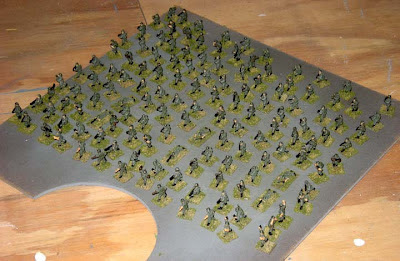After doing some searching on the web for photos and finding nothing, I did a stupid thing and ordered miniatures without seeing them first. Well, much to my surprise, this wild and crazy guy gambled right this time. Tonight I received a couple of Quality Castings 15mm M42 Dusters from Warweb.
I must say that I am quite pleased with this model. The detail is good, and the castings are pretty crisp. It comes in eight pieces as seen in the photo below.
Hull assembly is very simple and the fit of the parts is quite good, with only a little flash on the parts. The turret is a little trickier, but not too bad if you have a pic of an M42.
The turret is cast with the outer portion of the gun shields bent inward. The sprues must be clipped out, and the gun shields bent upward into proper position. Once in position the gun mount with the center portion of the shield will fit in place, and the guns tubes can be glued on. The guns have pins on the ends, but the holes in the gun mount must be drilled out a little before gluing in place. The view below shows after and before positions of the gun shields:
The turret comes in two pieces, a lower half and upper half, which join at a point below the turret ring. There is a pin in the front of the lower portion to help in aligning the two halves. I filed the glued surfaces level before gluing, then filed lightly around the portion of the turret that rests below the turret ring. With about 20 seconds work, it fit very nicely into the the hull.
Quality Castings models are sometimes a little smaller than some other manufacturers, so I took a couple size comparison photos:
The QC M42 is pictured with a QRF M47 medium tank, and one of my own 1/100 post war T34/85s. In the top photo, there is an Old Glory US infantrymen from their Vietnam line standing to the rear of the M42. The M42 was built on a modified M41 like tank chassis, and I have to say that I think it looks fine with respect to scale or size. I did not take measurements or calculate a scale for the M42, as I am not realy concerned with that.
Overall I am quite happy with the models and would recommend them to anyone needing some Cold War era air defense. I ordered from Warweb on the Tuesday before Thanksgiving and received my package in eight days. I received e-mail notification at the time of ordering, and at the time of shipping. In all good service resulting in a happy customer.
That's all for now, more gamer psycho-babble at you later.
I must say that I am quite pleased with this model. The detail is good, and the castings are pretty crisp. It comes in eight pieces as seen in the photo below.
Hull assembly is very simple and the fit of the parts is quite good, with only a little flash on the parts. The turret is a little trickier, but not too bad if you have a pic of an M42.
The turret is cast with the outer portion of the gun shields bent inward. The sprues must be clipped out, and the gun shields bent upward into proper position. Once in position the gun mount with the center portion of the shield will fit in place, and the guns tubes can be glued on. The guns have pins on the ends, but the holes in the gun mount must be drilled out a little before gluing in place. The view below shows after and before positions of the gun shields:
The turret comes in two pieces, a lower half and upper half, which join at a point below the turret ring. There is a pin in the front of the lower portion to help in aligning the two halves. I filed the glued surfaces level before gluing, then filed lightly around the portion of the turret that rests below the turret ring. With about 20 seconds work, it fit very nicely into the the hull.
Quality Castings models are sometimes a little smaller than some other manufacturers, so I took a couple size comparison photos:
The QC M42 is pictured with a QRF M47 medium tank, and one of my own 1/100 post war T34/85s. In the top photo, there is an Old Glory US infantrymen from their Vietnam line standing to the rear of the M42. The M42 was built on a modified M41 like tank chassis, and I have to say that I think it looks fine with respect to scale or size. I did not take measurements or calculate a scale for the M42, as I am not realy concerned with that.
Overall I am quite happy with the models and would recommend them to anyone needing some Cold War era air defense. I ordered from Warweb on the Tuesday before Thanksgiving and received my package in eight days. I received e-mail notification at the time of ordering, and at the time of shipping. In all good service resulting in a happy customer.
That's all for now, more gamer psycho-babble at you later.
































































































































































